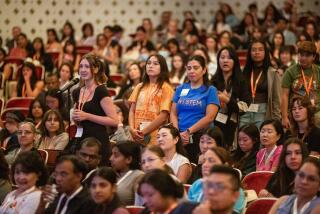Women’s Colleges : Coeducation: The number has dwindled but advocates say they offer unmatched advantages to female students.
Although women’s colleges have dwindled to just three in California--and there are no all-male universities left--those associated with single-sex schools say they offer benefits unmatched by coeducational campuses.
“Female students here are expected to take on leadership roles,” says Vickie Bates, assistant director of college relations at Mills College in Oakland, which has an enrollment of 774 women. “They’re stars on the athletic team, they’re editors of student newspapers, they’re leaders in student government. That’s what you need to prepare for the working world.”
Mills is the only women’s college in California that has no male undergraduates. Of the other two, Mount Saint Mary’s College in Los Angeles has 10 men enrolled out of about 800 students and Scripps College in Claremont allows cross-enrollment with the co-ed Claremont Colleges.
Mills students feel so strongly about not allowing men into undergraduate programs that they staged a strike last year after the school decided to open its doors to men because of dwindling enrollment. The board quickly rescinded its decision pending a five-year reassessment but says the college may be forced to go co-ed unless more women start attending.
There are 94 women’s colleges throughout the country, and studies indicate that students at such campuses are up to three times more likely to major in math or science than women at a co-ed school.
One reason may be that such campuses--where the majority of staff and administrators are women--provide students with important role models and mentors.
“There’s no subtle discouragement, no lowered expectations” said Nancy Bekavac, president of the all-female Scripps College in Claremont. She adds that “every study has shown that an incredibly disproportionate number of women who achieve high degrees of success in business and politics went to all-women’s colleges.”
What are the down sides to attending a women’s college?
Jean Dawes, a college adviser at Palo Alto High School, says such an environment may not reflect the real world.
“In the workplace, you’re going to have to work and compete with men and perhaps learning how to deal with that in a college environment is a good thing,” Dawes said.
Nonetheless, Dawes added that she almost always raises the idea of women’s colleges when she counsels students.
“I outline it as a blue-ribbon educational opportunity. Girls rarely ask, I’m almost always the one who brings it up.”
Another problem is finding yourself at a women’s college that suddenly decides to accept men, most often because of declining enrollment.
Wheaton College, a well-respected women’s college in Norton, Mass. which recently went co-ed, cited dwindling enrollment as the reason for being forced to open its doors to men.
“The college was suffering a long decline in the number of applicants and rather than . . . continue to shrink we decided . . . to go co-ed,” said Donald Stewart, executive director of public relations. “Only a small percentage of women are even willing to consider a single-sex college.”
But what about the prospects for a lively social life, which may be a major consideration among 18-year-old girls struggling with where to spend the next four years.
“It’s not like you’re put away or institutionalized in a convent, that image is totally false,” said Maria Avila, student body president at Mount Saint Mary’s College in Los Angeles.
Avila, a senior psychology major, says Mount Saint Mary’s has frequent social activities, including dances, with co-ed universities. At the same time, however, its all-female learning environment “gave me the opportunity to grow as a person,” Avila said. “I had the opportunity to express myself more than at a co-ed college, where women might feel intimidated by the men around them not to say anything.”
Her fears aren’t idle ones, says Peter Mirijanian, director of communications for the Women’s College Coalition, a Washington-based organization.
Mirijanian says studies done by a Harvard professor indicate that in class, college professors call on and make eye contact more frequently with male students than with their female counterparts.
“It’s hard to believe this still exists in 1991 but it’s true, when men are in the classroom they dominate the instruction and women don’t get the full benefit of participation,” he said.
And just because one attends a women’s college doesn’t mean there won’t be any men in the class. Scripps College for instance, allows cross-enrollment with the other Claremont Colleges, which means that many classes include male students. Mount Saint Mary’s Doheny campus near USC includes about 150 males in its 400-student enrollment. And there are 10 men enrolled at its Brentwood campus.
“It’s a special place at a particular time of your life,” says Sister Karen Kennelly, president of Mount Saint Mary’s College. She draws an analogy between all-women colleges and black colleges, both of which she says offer a unique learning experience.
“It gives women a sense that they are in charge and it gives them a sense of their own capacities and abilities as women.”
More to Read
Sign up for Essential California
The most important California stories and recommendations in your inbox every morning.
You may occasionally receive promotional content from the Los Angeles Times.










